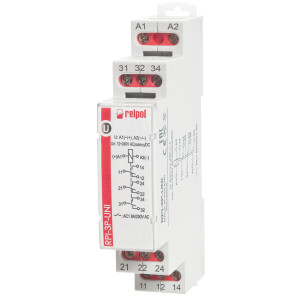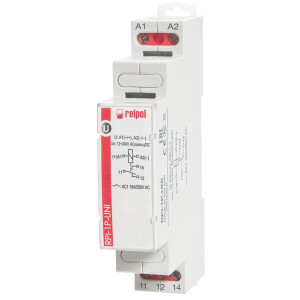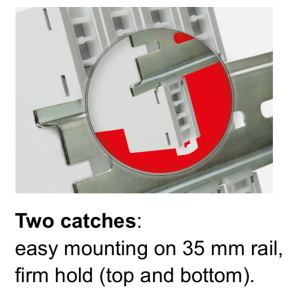Installation relays
| Quantity | Single price |
|---|---|
| 1 | 16,30 €* |
| 10 | 15,49 €* |
| 20 | 14,67 €* |
- Pre-order possible
-
Delivery time: 49 - 51 Workdays (Other countries)
| Quantity | Single price |
|---|---|
| 1 | 13,69 €* |
| 10 | 13,00 €* |
| 20 | 12,32 €* |
- 60 pcs. In stock
-
Delivery time: 4 - 6 Workdays (Other countries)
| Quantity | Single price |
|---|---|
| 1 | 13,98 €* |
| 10 | 12,86 €* |
| 20 | 11,58 €* |
- 30 pcs. In stock
-
Delivery time: 2 - 4 Workdays (Other countries)
| Quantity | Single price |
|---|---|
| 1 | 16,07 €* |
| 10 | 15,26 €* |
| 20 | 14,46 €* |
- 210 pcs. In stock
-
Delivery time: 2 - 4 Workdays (Other countries)
| Quantity | Single price |
|---|---|
| 1 | 13,98 €* |
| 10 | 12,86 €* |
| 20 | 11,58 €* |
- 12 pcs. In stock
-
Delivery time: 2 - 4 Workdays (Other countries)
| Quantity | Single price |
|---|---|
| 1 | 16,15 €* |
| 10 | 14,85 €* |
| 20 | 13,36 €* |
- Must be ordered. Ready for shipment in 5 days after order.
-
Delivery time: 7 - 9 Workdays (Other countries)
| Quantity | Single price |
|---|---|
| 1 | 23,47 €* |
| 10 | 21,59 €* |
| 20 | 19,43 €* |
- 5 pcs. In stock
-
Delivery time: 2 - 4 Workdays (Other countries)
| Quantity | Single price |
|---|---|
| 1 | 18,45 €* |
| 5 | 17,89 €* |
| 10 | 17,52 €* |
- 50 pcs. In stock
-
Delivery time: 5 - 7 Workdays (Other countries)
| Quantity | Single price |
|---|---|
| 1 | 17,26 €* |
| 5 | 16,39 €* |
| 10 | 16,05 €* |
- 155 pcs. In stock
-
Delivery time: 5 - 7 Workdays (Other countries)
| Quantity | Single price |
|---|---|
| 1 | 18,45 €* |
| 10 | 17,52 €* |
| 20 | 16,60 €* |
- 1 pcs. In stock
-
Delivery time: 4 - 6 Workdays (Other countries)
| Quantity | Single price |
|---|---|
| 1 | 17,26 €* |
| 5 | 16,39 €* |
| 10 | 16,05 €* |
- 23 pcs. In stock
-
Delivery time: 5 - 7 Workdays (Other countries)
| Quantity | Single price |
|---|---|
| 1 | 13,98 €* |
| 10 | 12,86 €* |
| 20 | 11,58 €* |
- 10 pcs. In stock
-
Delivery time: 2 - 4 Workdays (Other countries)
| Quantity | Single price |
|---|---|
| 1 | 28,83 €* |
| 10 | 26,53 €* |
| 20 | 23,88 €* |
- 27 pcs. In stock
-
Delivery time: 2 - 4 Workdays (Other countries)
| Quantity | Single price |
|---|---|
| 1 | 21,24 €* |
| 10 | 19,54 €* |
| 20 | 17,59 €* |
- 33 pcs. In stock
-
Delivery time: 2 - 4 Workdays (Other countries)
| Quantity | Single price |
|---|---|
| 1 | 17,85 €* |
| 10 | 16,42 €* |
| 20 | 14,78 €* |
- 12 pcs. In stock
-
Delivery time: 5 - 7 Workdays (Other countries)
| Quantity | Single price |
|---|---|
| 1 | 17,85 €* |
| 10 | 16,42 €* |
| 20 | 14,78 €* |
- 25 pcs. In stock
-
Delivery time: 2 - 4 Workdays (Other countries)
| Quantity | Single price |
|---|---|
| 1 | 23,47 €* |
| 10 | 21,59 €* |
| 20 | 19,43 €* |
- 40 pcs. In stock
-
Delivery time: 2 - 4 Workdays (Other countries)
| Quantity | Single price |
|---|---|
| 1 | 24,75 €* |
| 10 | 22,78 €* |
| 20 | 20,49 €* |
- 35 pcs. In stock
-
Delivery time: 2 - 4 Workdays (Other countries)
| Quantity | Single price |
|---|---|
| 1 | 20,65 €* |
| 5 | 20,03 €* |
| 10 | 18,79 €* |
- 34 pcs. In stock
-
Delivery time: 5 - 7 Workdays (Other countries)
| Quantity | Single price |
|---|---|
| 1 | 16,15 €* |
| 10 | 14,85 €* |
| 20 | 13,36 €* |
- 6 pcs. In stock
-
Delivery time: 2 - 4 Workdays (Other countries)
Installation relays / switching relays: The heart of your electrical projects
Installation relays, or switching relays, are not only an integral part of modern electrical installations, but also an indispensable tool for every electrician and installation professional. Whether as part of home automation or industrial control systems, these small but powerful devices make it possible to control circuits efficiently and safely.
What exactly are switching relays? A simple explanation for professionals.
An installation relay, also known as a switching relay, is an electromagnetically operated switch that is specifically designed to control circuits up to a certain amperage (16 A). They are typically used in conjunction with pushbuttons and switches and enable the central control of various electrical consumers. Additionally, installation relays can help save energy. Their ability to only deliver electricity to the consumer when it is actually needed means they help optimize energy consumption.
Areas of application for installation relays: From home automation to industrial control
Installation relays or switching relays are a true all-rounder when it comes to controlling electrical systems. They have become increasingly important in home automation in recent years, particularly due to the trend towards smart home technology. Here they not only enable the control of lighting and air conditioning, but also security systems such as surveillance cameras and alarm systems. They even play a role in intelligent energy control, for example by connecting solar panels with energy storage and the household grid.
In an industrial context, installation relays are essential for automating production lines, pump systems and other complex machines. In manufacturing processes, for example, they enable the synchronized operation of assembly lines and robot arms. They are also used in emergency and safety systems, for example to enable automatic switching to emergency generators in the event of a power failure.
The different types of installation relays: make contacts, changeover contacts and break contacts at a glance
Depending on the specific requirements of your project, you can choose between different types of installation relays:
- normally open contact (NO): Mainly for continuous closing processes, e.g. in lighting systems.
- Change over contact (CO): Suitable for complex control tasks that require switching between different consumers.
- normally closed contact (NC)r: Ideal for security systems that need to interrupt the energy supply under certain conditions, such as smoke.
Table for a quick overview:
| Contact type | Main application area | Example |
|---|---|---|
| NO Contact | Continuous closing processes | Lighting systems |
| CO Contactr | multiple switching options | Air conditioning systems, pumps |
| NC Contactr | Security applications | Smoke detectors, alarm systems |
Contact and support: How to get expert advice on installation relays and switching relays
If you have any questions or need expert advice, we are happy to help. Our professionals can advise you both online and over the phone to ensure you find the right product for your project.
There are essentially three types of contacts: normally open (NO), changeover (CO) and normally closed (NC). Normally open contacts pass current when the relay is activated. Changers can switch between two different current paths. Normally closed contacts interrupt the flow of electricity when the relay is activated.
Selecting the correct installation relay depends on several factors, including the type of application, required current flow, and specific control requirements. It is advisable to conduct a thorough analysis of the requirements before purchasing.



















































